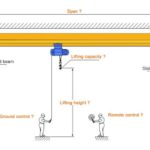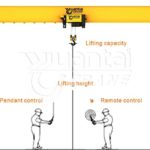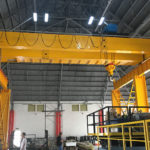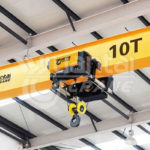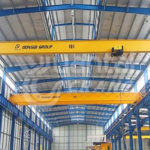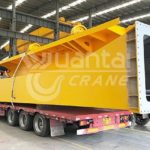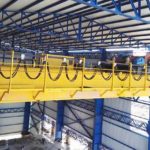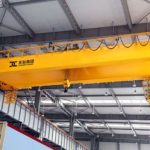What is the Top Running Crane?
The top-running crane is a kind of overhead crane also called bridge crane, which has a fixed rail or track system installed on the top of each runway beam. The runway beams can allow the end trucks to carry the bridge and hoist along the top of the runway system. Generally, top-running cranes are the perfect solutions for working places with limited headroom. Because they are easier to support long bridge spans and have larger lifting capacities, at 20 tons or more. And they are also easier to install and service.


Top Running Overhead Cranes Come in Two Options:
Top running bridge cranes can be designed and manufactured in a single girder or double girder bridge design. A single girder bridge utilizes an under-hung trolley and hoist, while a double girder design most often utilizes a top running trolley and hoist.
Single Girder Top Running Overhead Crane
What is single girder top running overhead crane? -A single bridge beam attached to the top of two runways, this crane can provide a higher lifting range due to greater headroom space under the beam (because it is mounted on the top of the runway). When constructed in a four-sided box girder configuration, the bridge girder can handle higher load capacities and cover longer spans. Similar to their under running counterparts, top running single girder cranes are generally utilized in handling loads under 15 tons.

A top-running configuration can also be beneficial when extremely high clearance is necessary or when the facility has issues with low headroom. Because a top-running system travels above the overhead runway, it allows for additional clearance below the bridge. Providing you excellent value for your application, single girder designs allow you to be cost-effective without compromising performance. Over the lifetime of the crane, you will save on new support structures as it has reduced wheel loads. This allows you to add more lifting capabilities to your runway structure without upgrading.
Double Girder Top Running Overhead Crane
What is double girder top running overhead crane?-Typically double girder top running cranes apply to heavier capacity (more than 10 tons) and higher duty applications, these systems utilize two bridge beams set atop the runway end trucks. The hoist and trolley are mounted on top of the two bridge beams to create greater headroom under the crane. These overhead cranes can accommodate typical spans as long as 120 feet but can go even longer for their construction. Like the single girder top running crane, double girder models provide greater lifting height, allowing the hoist to lift a load as high as the depth of the girders, and since the hoist is mounted on top of the girders, the hook can also be raised between the girders.

A double girder top-running crane system offers the most overhead space possible for facilities where it’s a major concern. Even so, most facilities with overhead space concerns can simply use an under-running configuration with a double or single girder bridge crane, without having to install a top-running system. Designed for applications with load capacities typically over 25 tons, double girder cranes are used when you need a complete lifting solution. Double girder cranes give a better height of lift compared to a single girder crane as the hook travels between the beams.
What Can the Top-running Crane Do for You?
Top-running designs are useful for lifting and the transfer of very heavy loads.
If you have loads that are 20 tons or more that need to be lifted, a top-running system is the most suitable solution. They are designed for heavy lifting rather than ease of use and flexibility. Top running cranes require the use of a bracket attached to the building support steel or independent support columns for heavier capacities. If your loads are 20 tons or less, using a lighter and more flexible under-running crane system is usually the best option.
A top-running configuration can also be beneficial when extremely high clearance is necessary or when the facility has issues with low headroom.
Because a top-running system travels above the overhead runway, it allows for additional clearance below the bridge. A double girder top-running crane system offers the most overhead space possible for facilities where it’s a major concern. Even so, most facilities with overhead space concerns can simply use an under-running configuration with a double or single girder bridge crane, without having to install a top-running system.
Both single girder top-running and double girder top running cranes can be adapted to almost all kinds of applications.
They are designed for the utmost productivity and safety inside your facility. Typically, the single beam top running crane is suitable for light duty applications, such as light manufacturing and machine shops, warehousing, light assembly lines and repair shops. Whereas the double girder overhead crane is commonly found in heavy duty industries, such as steel mills, large machine shops and paper mills.


Reasons for Choosing a Top-running Crane
Top-running cranes run on a fixed rail mounted on top of each runway beam, which allows the end trucks to carry the girder and hoist along the top. These cranes can be set up as a single girder or double girder depending on the application needs. A single girder has a trolley and hoist mounted on the bottom, whereas a double girder uses a top running trolley and hoist, allowing for additional lift height and a higher hook height. Some key advantages of top-running overhead cranes include:
- No limiting capacity. This allows for the ability to handle both small and large loads.
- Added lift height. Being mounted on top of each runway beam allows for increased lift height, which is beneficial to buildings with limited headroom.
- Built for higher capacities. Top-running overhead cranes are built larger than under-running cranes to grant them the ability to handle higher capacities.
- Easy installation. Since the crane is supported by the runway beams, it eliminates the suspended load factor to make installation simple.
- Less maintenance. As time goes on; top-running overhead cranes do not need; as much maintenance other than the routine checking of the tracking for proper alignment and any issues.
Each of our top running bridge cranes is available to be customized according to your requirements. With our excellent technical team, we will design a proper solution for your business needs no matter what your application is.
If you have any crane needs, please feel free to contact us and we will reply to you as soon as possible.
Applications for Top Running Cranes in the Philippines
The versatility of top running cranes makes them suitable for a wide range of applications in the Philippines. Here are some key industries that can leverage their benefits:
- Manufacturing: From automotive components to electronics and machinery, top running cranes are essential for lifting and transporting heavy equipment, raw materials, and finished goods within production facilities.
- Shipbuilding: These cranes play a vital role in shipyards, lifting massive steel sections, prefabricated parts, and even entire engines during the shipbuilding process.
- Construction: Top running cranes are valuable assets on construction sites, assisting with the movement of heavy building materials, precast concrete elements, and steel beams.
- Power Generation: In power plants, top running cranes are crucial for handling heavy turbines, generators, and transformers during maintenance and repair operations.
- Warehousing and Logistics: These cranes optimize the storage and retrieval of goods within warehouses, maximizing space utilization and expediting order fulfilment processes.
Choosing the Right Top Running Crane for Your Needs

With the growing demand for top running cranes in the Philippines, several reputable manufacturers and suppliers offer their products in the market. Here are some key factors to consider when selecting the right crane for your specific needs:
- Capacity: Carefully evaluate the maximum weight you need the crane to lift.
- Span Length: This refers to the distance the crane can travel along the elevated tracks.
- Lifting Height: Determine the required height to which the crane needs to raise loads.
- Duty Cycle: Consider how frequently you will be using the crane and the intensity of each operation.
